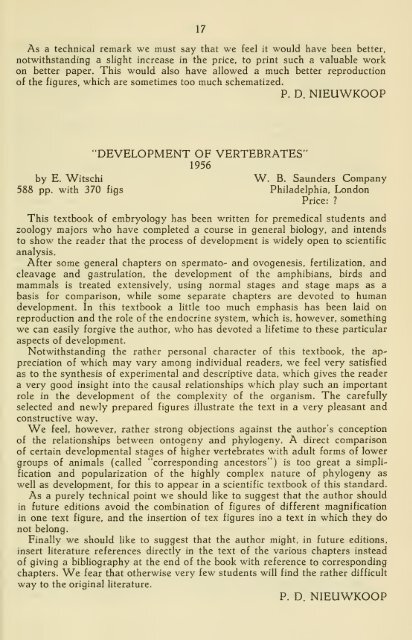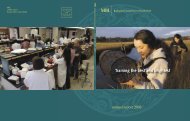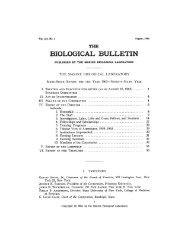View/Open - HPS Repository
View/Open - HPS Repository
View/Open - HPS Repository
You also want an ePaper? Increase the reach of your titles
YUMPU automatically turns print PDFs into web optimized ePapers that Google loves.
17<br />
As a technical remark we must say that we feel it would have been better,<br />
notwithstanding a slight increase in the price, to print such a valuable work<br />
on better paper. This would also have allowed a much better reproduction<br />
of the figures, which are sometimes too much schematized.<br />
P. D. NIEUWKOOP<br />
"DEVELOPMENT OF VERTEBRATES"<br />
1956<br />
by E. Witschi W. B. Saunders Company<br />
588 pp. with 370 figs Philadelphia, London<br />
Price: ?<br />
This textbook of embryology has been written for premedical students and<br />
zoology majors who have completed a course in general biology, and intends<br />
to show the reader that the process of development is widely open to scientific<br />
analysis.<br />
After some general chapters on spermato- and ovogenesis, fertilization, and<br />
cleavage and gastrulation, the development of the amphibians, birds and<br />
mammals is treated extensively, using normal stages and stage maps as a<br />
basis for comparison, while some separate chapters are devoted to human<br />
development. In this textbook a little too much emphasis has been laid on<br />
reproduction and the role of the endocrine system, which is, however, something<br />
we can easily forgive the author, who has devoted a lifetime to these particular<br />
aspects of development.<br />
Notwithstanding the rather personal character of this textbook, the appreciation<br />
of which may vary among individual readers, we feel very satisfied<br />
as to the synthesis of experimental and descriptive data, which gives the reader<br />
a very good insight into the causal relationships which play such an important<br />
role in the development of the complexity of the organism. The carefully<br />
selected and newly prepared figures illustrate the text in a very pleasant and<br />
constructive way.<br />
We feel, however, rather strong objections against the author's conception<br />
of the relationships between ontogeny and phylogeny. A direct comparison<br />
of certain developmental stages of higher vertebrates with adult forms of lower<br />
groups of animals (called "corresponding ancestors") is too great a simpli-<br />
fication and popularization of the highly complex nature of phylogeny as<br />
well as development, for this to appear in a scientific textbook of this standard.<br />
As a purely technical point we should like to suggest that the author should<br />
in future editions avoid the combination of figures of different magnification<br />
in one text figure, and the insertion of tex figures ino a text in which they do<br />
not belong.<br />
Finally we should like to suggest that the author might, in future editions,<br />
insert literature references directly in the text of the various chapters instead<br />
of giving a bibliography at the end of the book with reference to corresponding<br />
chapters. We fear that otherwise very few students will find the rather difficult<br />
way to the original literature.<br />
P. D. NIEUWKOOP
















